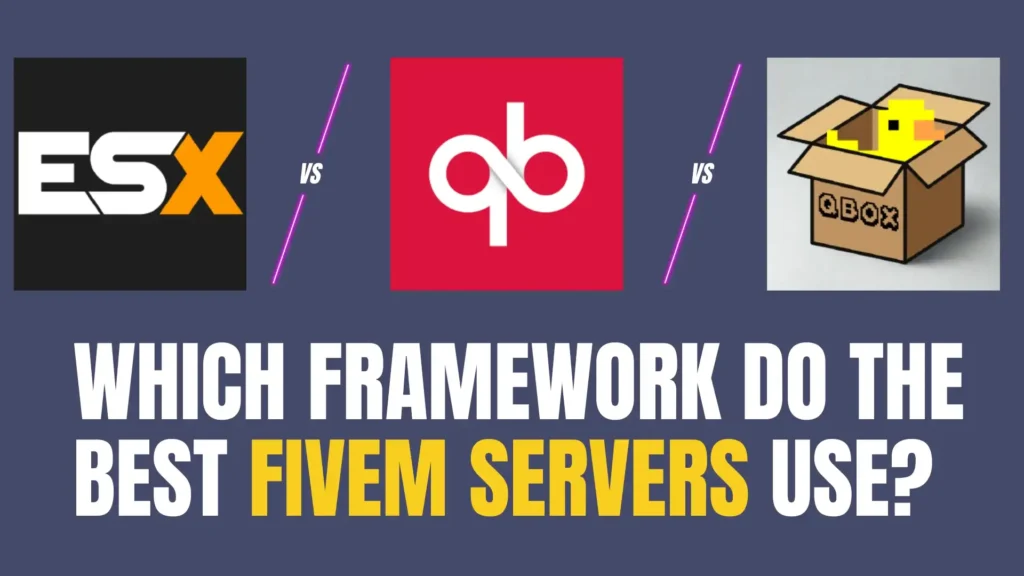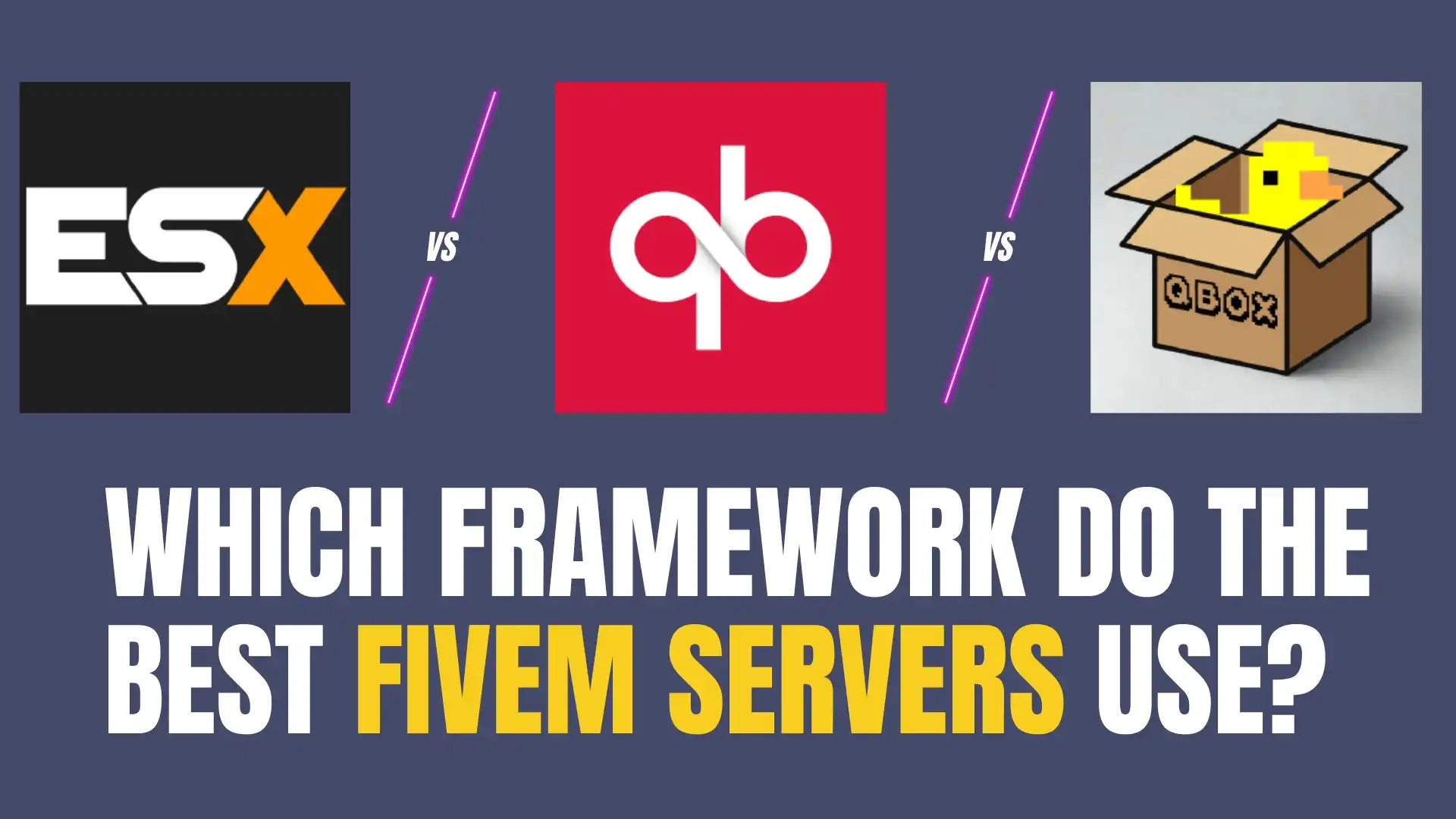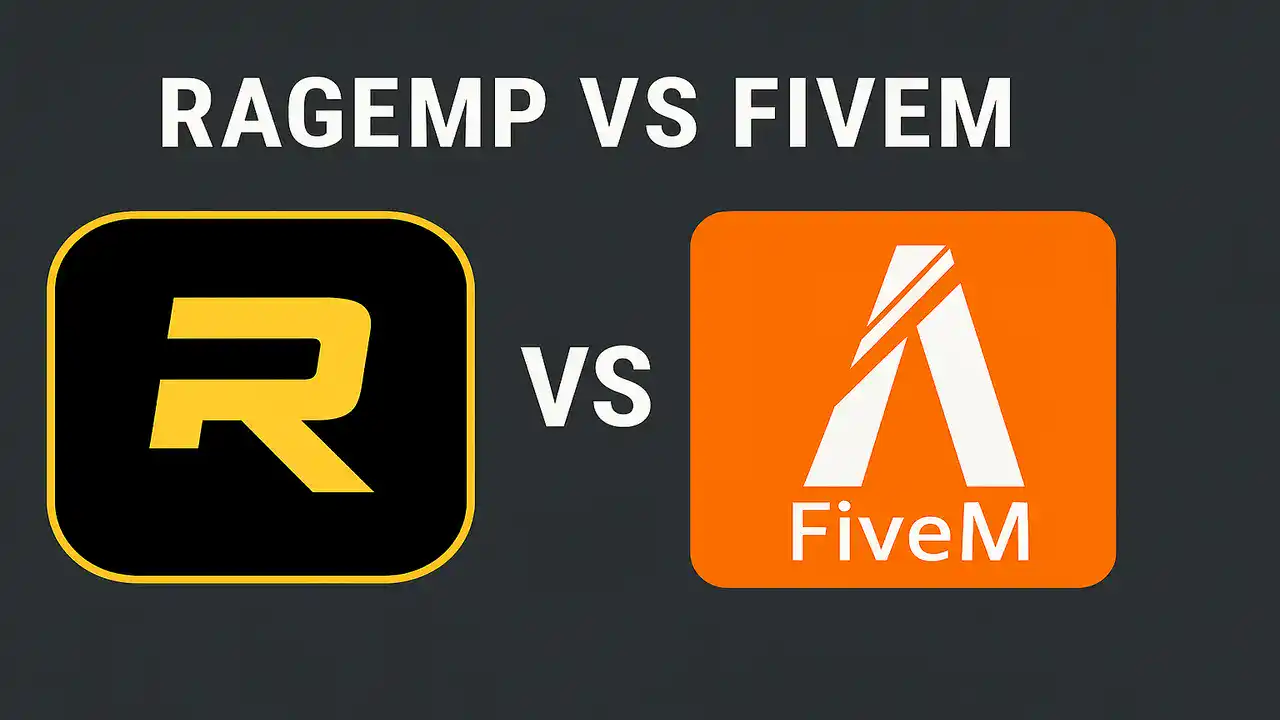If you’re building a FiveM roleplay server in 2025, one of your first major decisions is choosing the right framework. Walk into any server development Discord, and you’ll hear passionate debates about ESX, QBCore, and the newer QBox framework. Each has devoted followers who swear their choice is superior, but the reality is more nuanced.
I’ve spent years working with all three frameworks, building servers from the ground up, and migrating between systems. After developing dozens of servers and testing hundreds of scripts across different frameworks, I’ve learned that the “best” framework depends entirely on your specific needs, technical expertise, and long-term vision.
Let’s break down exactly what separates these frameworks and which one actually makes sense for your server.
Understanding FiveM Frameworks: What They Actually Do
Before diving into comparisons, it’s worth understanding what a framework actually does for your FiveM server. At its core, a framework is the foundational codebase that handles essential roleplay mechanics: player identity, inventory systems, job structures, economy, and database interactions.
Think of your framework as the operating system for your roleplay server. Just as you wouldn’t build a computer application by writing directly to hardware, you don’t want to code every roleplay feature from scratch. The framework provides pre-built systems and standardized methods that developers use to create FiveM scripts that work cohesively together.
The framework you choose determines:
- Which scripts and resources will work on your server
- How difficult custom development will be
- What optimization challenges you’ll face
- How easily you can find developers
- The overall structure of your server’s codebase
ESX: The Industry Standard with the Largest Ecosystem
ESX (ES Extended) has been the dominant FiveM framework since the early days of roleplay servers. If you’ve played on any established FiveM server in the past few years, chances are it was running ESX.
The ESX Advantage: Maturity and Resources
The biggest advantage ESX offers is its massive ecosystem. Because it’s been around the longest, ESX has:
The largest script library available. You’ll find thousands of free and premium FiveM scripts built specifically for ESX. Need a custom banking system? There are dozens of options. Want a unique job system? You’ll find everything from basic implementations to complex, feature-rich alternatives.
The most extensive MLO compatibility. Most FiveM MLOs are designed with ESX in mind, with many including pre-configured ESX scripts for doors, inventories, and job interactions. While MLOs are technically framework-agnostic, the accompanying scripts are usually ESX-first.
The easiest hiring process. When you post a job listing for a FiveM developer, the majority of respondents will have ESX experience. This isn’t just about quantity—it’s about speed. ESX developers can jump into your codebase and start contributing immediately because they already know the structure.
Proven stability at scale. ESX has powered servers with hundreds of concurrent players for years. The framework’s performance characteristics are well-documented, and most optimization guides focus on ESX because that’s what most servers run.
ESX’s Weaknesses: Legacy Code and Inconsistency
However, ESX isn’t perfect. Its age shows in several ways:
Inconsistent code quality. Because ESX has been around so long and has had many contributors, the codebase quality varies significantly. Core systems use different coding conventions, and some components feel dated compared to modern Lua practices.
Fragmented versions. There are multiple ESX variants (ESX Legacy, older ESX versions, custom forks), and not all scripts work across all versions. This fragmentation creates compatibility headaches, especially when using older scripts with newer ESX versions.
Performance overhead. ESX wasn’t built with modern optimization techniques in mind. While it works fine for smaller servers, pushing 200+ players requires significant optimization work and potentially rewriting core systems.
Database structure limitations. ESX’s database design reflects older design patterns. Scaling to very large player databases or implementing complex data relationships sometimes requires creative workarounds.
QBCore: The Modern Alternative Built for Performance
QBCore emerged as a response to ESX’s limitations, designed from the ground up with modern coding practices and performance optimization in mind. It’s become the framework of choice for many newer servers and experienced developers frustrated with ESX’s quirks.
What Makes QBCore Different
Cleaner, more consistent codebase. QBCore uses modern Lua patterns throughout, with better code organization and more consistent naming conventions. If you’re a developer, working in QBCore feels more professional and maintainable than ESX.
Better performance out of the box. QBCore was built with optimization as a priority. It uses more efficient database queries, better event handling, and smarter resource management. For servers pushing high player counts, this matters significantly.
Active development and community. The QBCore community is highly engaged, with regular updates, bug fixes, and new features. The official QBCore GitHub is well-maintained, and community support through Discord is responsive and helpful.
Modern framework architecture. QBCore embraces newer FiveM features and capabilities. It’s designed to take advantage of current server performance best practices rather than being retrofitted to accommodate them.
QBCore’s Growing Ecosystem
The QBCore ecosystem has matured rapidly. While still smaller than ESX’s, you’ll now find:
Extensive script availability. Most popular FiveM scripts now have QBCore versions, and many premium developers release QBCore and ESX versions simultaneously. The gap in available resources has narrowed considerably.
Dedicated job systems. QBCore has excellent FiveM jobs implementations with detailed progression systems, realistic mechanics, and engaging gameplay. Many developers prefer building jobs for QBCore because of its cleaner structure.
Strong MLO integration. Modern FiveM MLOs increasingly ship with QBCore scripts alongside ESX versions. The MLO community has recognized QBCore’s growth and adapted accordingly.
QBCore’s Limitations
Smaller developer pool. While growing, there are fewer QBCore developers available for hire compared to ESX. You might wait longer to find qualified help or pay premium rates for experienced QBCore developers.
Some script gaps remain. Certain niche or older scripts still only have ESX versions. While the essential systems are all covered, you might occasionally need to convert a specific script yourself or commission a conversion.
Less long-term documentation. Because QBCore is newer, there are fewer comprehensive guides, video tutorials, and forum discussions compared to ESX’s extensive knowledge base built over years.
QBox: The Newest Contender Combining Both Approaches
QBox is the newest framework on the scene, attempting to bridge the gap between ESX and QBCore. It’s essentially a hybrid approach that maintains compatibility with QBCore scripts while incorporating improvements and alternative approaches to common systems.
QBox’s Value Proposition
QBCore script compatibility. QBox maintains compatibility with QBCore scripts, meaning you can use the established QBCore ecosystem while benefiting from QBox’s enhancements. This solves the “small ecosystem” problem that plagued QBCore’s early days.
Performance optimizations. QBox includes additional optimization work beyond standard QBCore, with refined database queries, improved event handling, and better resource management.
Improved inventory system. One of QBox’s main improvements is a redesigned inventory system that offers better performance and more features than the standard QBCore inventory.
Active modernization efforts. The QBox team actively works on modernizing and improving systems, taking feedback from the community and implementing requested features regularly.
Why QBox Hasn’t Dominated Yet
Very small adoption. QBox is still relatively unknown compared to ESX and QBCore. Most server owners haven’t heard of it, and many developers haven’t worked with it yet.
Uncertain long-term viability. With such a small user base, there’s always risk around whether QBox will gain enough traction to become self-sustaining with community contributions and long-term development.
Limited unique features. While QBox offers improvements over QBCore, they’re evolutionary rather than revolutionary. The benefits aren’t dramatic enough to convince established servers to migrate.
Developer availability. Finding developers experienced with QBox specifically is extremely difficult. You’ll likely hire QBCore developers and have them learn QBox on the job.
The Real Question: Which Framework Should YOU Choose?

Forget the Reddit debates and Discord arguments. Here’s how to actually make this decision:
Choose ESX if:
You’re new to FiveM server development. ESX’s massive ecosystem means you’ll find solutions to every problem you encounter. Stuck on something? There’s probably a YouTube tutorial, forum thread, or Discord discussion covering exactly your issue.
You want maximum script selection. If having access to the absolute largest library of scripts matters more than code quality or performance, ESX wins by sheer volume of available resources.
You need to hire developers quickly. The ESX developer pool is largest, making it easiest to find help when you need it. For server owners who aren’t technical themselves, this accessibility is crucial.
You’re building a casual/medium-sized server. If you’re not planning to push 200+ players or running a highly competitive server, ESX’s performance limitations won’t affect you. It works perfectly fine for most use cases.
Choose QBCore if:
You have technical expertise. If you or your team can code, you’ll appreciate QBCore’s cleaner structure and better development experience. Working in well-organized code is genuinely more pleasant.
Performance is a priority. Planning to build a high-population server or running on limited hardware? QBCore’s optimization advantages become meaningful in these scenarios.
You want modern infrastructure. QBCore better reflects current best practices in FiveM development. Building on modern foundations means less technical debt to deal with later.
You’re building something unique. If your server concept requires heavy custom development, QBCore’s cleaner architecture makes custom work significantly easier to implement and maintain.
Choose QBox if:
You’re already experienced with QBCore. If you know QBCore well and want incremental improvements without changing ecosystems, QBox offers that evolution.
You value cutting-edge optimization. For extremely performance-sensitive servers where every millisecond matters, QBox’s additional optimization work might justify the trade-offs.
You like being an early adopter. If you enjoy being part of emerging communities and contributing to newer projects, QBox needs users like you.
Honestly, for most server owners, I’d steer you toward either ESX or QBCore and away from QBox. The risk of betting on a framework with unclear long-term viability isn’t worth the modest improvements it offers over QBCore.
Detailed comparison:
ESX
QBCore
QBox
EFlowchart
ESX Framework Highlight
ESX
The Industry Standard
QBCore Framework Highlight
QBCore
Modern Performance Leader
Performance Comparison Graph
Server Performance Comparison (200 Players)
| Metric | ESX | QBCore | QBox |
|---|---|---|---|
| Average Server Tick Time (ms) | 15.2 | 10.8 | 9.5 |
| RAM Usage (MB) | 2,400 | 1,850 | 1,750 |
| Database Query Time (ms) | 45 | 28 | 25 |
| Script Load Time (seconds) | 12.5 | 8.2 | 7.8 |
*Benchmark data from typical server configurations with standard script loads
The Framework Migration Myth
One common piece of advice you’ll hear is “start with ESX, migrate to QBCore later if needed.” This sounds logical but often creates more problems than it solves.
Framework migration is painful. Every script needs conversion, database structures must be restructured, player data requires careful migration, and thorough testing is essential to avoid losing player progress or creating game-breaking bugs. Large servers have spent months on framework migrations.
Instead of planning to migrate later, choose the right framework from the start. Consider your six-month and one-year plans. If you’re serious about building a large, optimized, professional server, start with QBCore even though it’s slightly harder initially. If you want to launch quickly with maximum script options and less technical overhead, start with ESX and optimize it as you grow.
Beyond the Framework: What Actually Makes Servers Successful
Here’s the uncomfortable truth: your framework choice matters far less than you think.
The most successful FiveM servers aren’t successful because of their framework. They succeed because of:
Quality FiveM MLOs creating immersive environments. Players remember beautiful, detailed interiors and unique locations, not which framework powered the inventory system.
Well-implemented FiveM jobs providing engaging gameplay. Whether a job system runs on ESX or QBCore matters far less than whether it’s fun, balanced, and rewarding to play.
Thoughtfully chosen and configured FiveM scripts. Players experience your script selection, not your framework. A server with carefully chosen, well-configured scripts on ESX will outperform a server with hastily selected scripts on QBCore.
Strong community management and server culture. This has nothing to do with technical choices and everything to do with how you run your community.
Consistent performance and uptime. Yes, framework affects this, but server hosting, proper configuration, and resource optimization matter more.
Making Your Decision: A Practical Framework
Stop overthinking this choice. Here’s your decision-making framework:
- Assess your technical capability honestly. Can you code in Lua? Do you have experienced developers? If yes, QBCore becomes more attractive. If no, ESX’s larger resource pool helps compensate.
- Define your server’s scope. Small casual server? Either framework works fine. Large competitive server? QBCore’s performance advantages matter more.
- Check specific script requirements. Are there specific FiveM scripts, FiveM jobs, or features absolutely essential to your server concept? Make sure they exist for your chosen framework.
- Consider your hiring needs. Will you need to hire developers? How quickly? ESX’s larger developer pool might outweigh QBCore’s technical advantages if you need frequent help.
- Make the choice and commit. Pick one and move forward. You’ll learn and adapt regardless of which you choose. Indecision costs you more than making an imperfect choice.
The Bottom Line
ESX remains the safe, practical choice for most server owners—especially those new to FiveM development. Its massive ecosystem, extensive documentation, and large developer community make it the path of least resistance.
QBCore is the better technical foundation for experienced developers and ambitious projects planning for high performance and scalability. If you have the technical chops to handle its slightly smaller ecosystem, QBCore rewards you with cleaner code and better performance.
QBox is interesting but too niche to recommend for most projects. Unless you have specific reasons to use it, stick with the proven options.
Ultimately, your framework choice matters less than the quality of your FiveM MLOs, FiveM scripts, and FiveM jobs you implement on top of it. Focus on building an engaging, well-optimized, beautifully designed server experience. Do that well, and players won’t know or care which framework is running under the hood.
Choose the framework that best matches your technical abilities and server goals, then stop second-guessing yourself and start building something great.
Looking for high-quality resources for your FiveM server regardless of framework? Check out our extensive collection of FiveM scripts, FiveM MLOs, and FiveM jobs at fivem.store.




